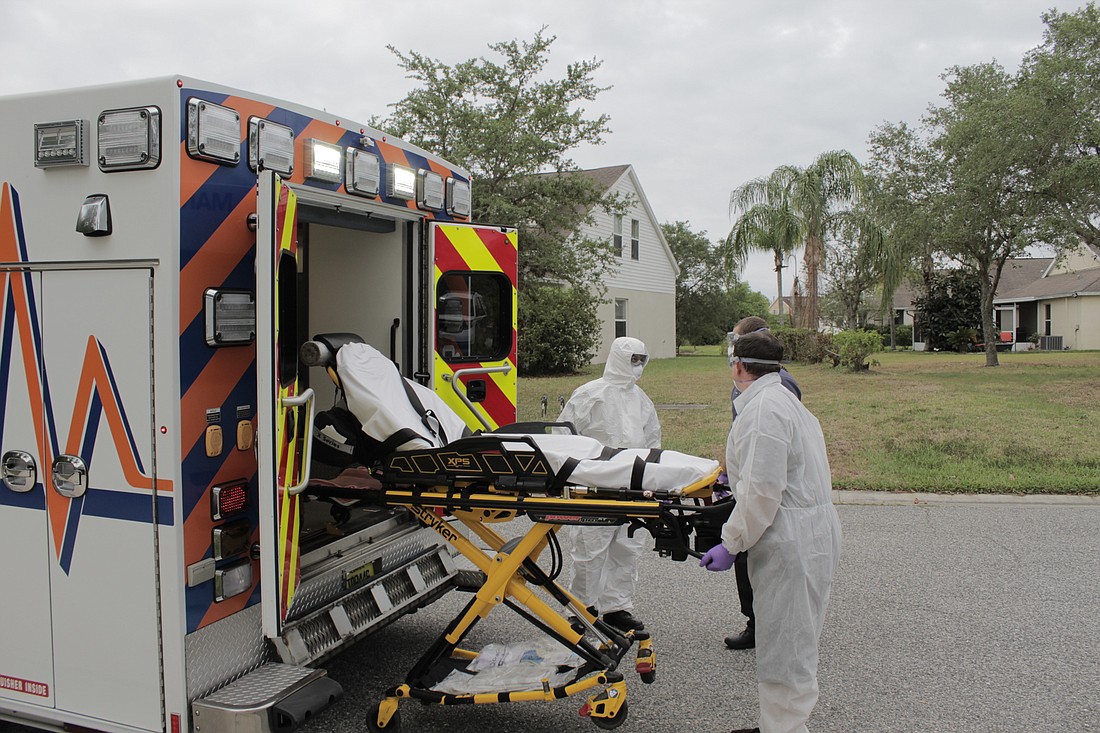- March 16, 2025
-
-
Loading

Loading

It was just a few months ago when Manatee County’s Emergency Medical Services and fire department personnel had just one primary thought in mind as they answered a medical call.
That was the health of the person or persons who needed help.
COVID-19 has changed that dynamic.
Now EMS and fire department personnel have to be worried about their own health more than ever before.
The reasoning is simple. If first responders have been exposed to COVID-19 and are showing symptoms, they can’t take care of the public.
Even the threat of contracting COVID-19 has put first responders on the sideline and that adds additional stress to the remaining workforce during a challenging time.
Supervisors from both the county’s EMS and fire services recognize the importance of working together to keep first responders ready to serve East County.
East Manatee Fire Rescue Chief Lee Whitehurst said EMS and fire districts created a “unified command” system in late March to ensure fire districts and EMS are working together with policies and procedures. They are jointly stockpiling personal protection equipment and have a distribution plan in place.
Each week, leaders in the unified command work together to develop an action plan for the following week.
Whitehurst also said the unified command leaders are working to calculate a “burn rate” for personal protection equipment, and they are working with residents and groups to obtain homemade reusable masks and gowns for employees.
Masks must be of a particular quality and design to be approved for use.
“We have a goal to get in the hands of every firefighter and paramedic reusable, washable masks that can be used for normal, routine-type of calls and save the N95 masks for the higher acuity calls,” Whitehurst said.
Doing so, also reserves other masks for patients.
“The level of service in Manatee County has not diminished,” Whitehurst said. “If anything, I think it’s strengthened. We’re working together great.”
The work started two months ago to deal with a COVID-19 threat that county health officials say isn't expected to peak until early May.
It was in mid-February when Larry Luh remembered Manatee County Public Safety Director Jacob Saur telling him it would be a good idea to dust off the county’s stash of personal protection equipment and other supplies required for a disease outbreak.
Saur suspected COVID-19, which was starting to wreak havoc in Europe, would come to the U.S., and Manatee County would need to be ready.
Luh, assistant chief of operations for Manatee County’s Emergency Medical Services Division, began evaluating the county’s cache of N95 masks, surgical masks, gowns and PAPRs (self-contained hoods with filtration systems).
“We had an exposure plan for H1N1 and Ebola going back four or five years,” Luh said. “I pulled out our plan, started counting (supplies). We started ordering.”
On March 8, Manatee County EMS responded to its first call for a COVID-19 positive patient with respiratory issues.
“That date, for me, is the date that started everything we’re doing today,” Luh said.
Jimmy Crutchfield, chief of Manatee County EMS, said there have been bold protocol adjustments to ensure first-responders are safe as they continue working to serve the public’s medical needs.
For example, after an individual calls 911 for a medical emergency, paramedics now arrive and try to assist a patient outside, if possible, to avoid entering the home.
If they must enter, initially only one paramedic goes in to minimize exposure. He or she wears protective gear regardless of the call.
“It’s all about retaining the workforce,” Crutchfield said. “When an employee gets exposed, they get taken off (the workforce) based on (Centers for Disease Control and Prevention) guidelines. Last week, we had a very high risk exposure, and we lost six employees.”
Saur has advocated for the public to stay home, as Florida Gov. Ron DeSantis has mandated, and for Manatee County to extend is nighttime curfew, which runs from 11 p.m. to 5 a.m. He said since the curfew began April 3, 911 calls during that time have dropped nearly 20%. Such measures, he said, help minimize risk to public safety personnel and healthcare workers, "flatten the curve" and ensure the healthcare system does not become overwhelmed.
Luh said emergency services’ plans take into account their workforce could be depleted, but the county hopes to avoid that scenario by protecting employees adequately.
Still, there is added stress on the system. Crutchfield said EMS employees are working overtime to cover shifts by those taken off the front lines.
He said high risk exposures of employees require 10 days of isolation plus another four days wearing a mask, if no symptoms show. With a medium-level risk exposure, employees can continue working, but must always wear a mask. Low-risk does not require changes.
For the county’s 152 EMS personnel, there had been 17 high risk, 30 medium risk and three low risk incidents of COVID-19 exposure as of April 16, Crutchfield said.
Luh, who serves as the county’s exposure control officer, is tasked with determining the COVID-19 exposure level for employees.
He said so far there have not been more than eight employees out of work at any one time.
“We keep our fingers on the pulse,” he said.
Luh has been working closely with East Manatee Fire Rescue District Deputy Chief Will Hall, who is monitoring risk for Manatee County firefighters. On the fire department side, there have been 21 incidents with possible exposure. Of them, five were high risk. One such incident required three firefighters being taken off the schedule for 10 days.
In March, Crutchfield created a self-monitoring tool used by EMS and the county’s fire districts. Employees have their own thermometers, and each day they chart their temperature and symptoms, such as a cough, sore throat or runny nose.
If there are concerns, a supervisor reaches out to check on that employee to make sure it’s still a good idea for him or her to come to work.